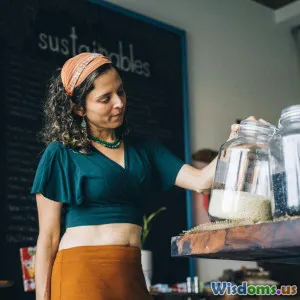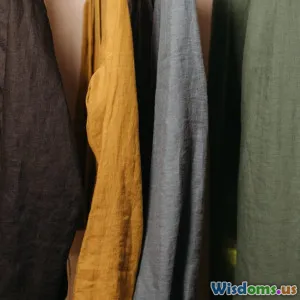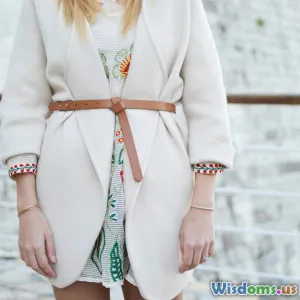
5 Surprising Myths About Ethical Fashion Sourcing Busted
8 min read Uncover the truth behind ethical fashion sourcing with 5 myths debunked, empowering you to make informed and responsible wardrobe choices. (0 Reviews)
5 Surprising Myths About Ethical Fashion Sourcing Busted
Ethical fashion sourcing is often shrouded in misconceptions that prevent many consumers and designers from embracing this crucial movement. From high costs to limited options and vague claims, myths abound that cloud judgments, stall progress, and diminish the real impact ethical sourcing can have on our planet and society. This article dives deep, busting five of the most persistent myths so that you can shop and create with clarity and purpose.
Myth 1: Ethical Fashion Sourcing Means Paying Way More
One of the most pervasive myths is that ethical fashion sourcing invariably leads to exorbitant prices. While many people associate sustainable or fair trade clothing with premium pricing, this isn’t always true.
Reality Check: Ethical sourcing ensures fair wages, safe working conditions, and environmentally responsible materials—but that does not mean margins must be inflated.
Take the example of Patagonia, a brand widely recognized for its commitment to ethical practices. Patagonia considers long-term sustainability, which actually reduces waste and costs over time. They invest in durable materials that extend garment life, ultimately offering better value. Similarly, Everlane’s “Radical Transparency” approach allows consumers to see exactly where money is spent, often revealing that ethical garments can be comparable in price to fast fashion when you account for true value.
Moreover, small-scale brands often use local sourcing, which can reduce transportation costs and barriers, enabling competitive pricing.
Key takeaway: Paying slightly more may be necessary in some cases, but ethical fashion isn’t always a luxury. It’s about valuing quality, transparency, and impact.
Myth 2: Ethical Sourcing Restricts Style and Variety
Critics argue that embracing ethical fashion limits choices to dull or basic designs that don’t keep pace with trends.
Reality Check: Ethical sourcing doesn’t curtail creativity or options—it inspires innovation.
For instance, firms like Reformation combine on-trend, fashion-forward styles with strict sustainability criteria. Designers often experiment with deadstock fabrics, organic textiles, and innovative recycled materials to craft beautiful pieces with unique stories.
A report by Common Objective (2023) noted that more than 60% of ethical brands are expanding their collections yearly, incorporating diverse aesthetics not limited by mass-production demands.
Additionally, vintage and upcycled fashion have blooming scenes worldwide, turning supposed limitations into creative goldmines.
Key takeaway: Ethical sourcing pushes fashion into new creative realms rather than confines it.
Myth 3: Ethical Fashion Sourcing Is Not Transparent or Traceable
Skeptics often claim that “ethical” labels are marketing ploys with no way to verify claims.
Reality Check: Transparency is increasingly becoming the cornerstone of ethical sourcing.
Many brands now utilize blockchain technology and digital traceability platforms to track garments from fiber to finished product. For example, TextileGenesis offers a blockchain-based certification system for organic cotton to ensure authenticity.
Third-party certifications such as Fair Trade Certified, GOTS (Global Organic Textile Standard), and OEKO-TEX provide credible validation to consumers.
Moreover, responsible brands openly share their supplier information and audit processes, setting industry benchmarks.
Key takeaway: Ethical sourcing demands transparency—and tools and certifications make it verifiable.
Myth 4: Ethical Fashion Has Minimal Environmental Impact
Another myth assumes ethical sourcing is merely a marketing buzzword with negligible real-world benefits for the environment.
Reality Check: Ethical fashion is a significant positive force for environmental stewardship.
Fibre production is one of apparel’s biggest environmental burdens, with cotton and synthetic fibers causing heavy water use and pollution. Ethical sourcing prioritizes organic fibers, biodegradable materials, and water-efficient processes.
Examples like Stella McCartney’s partnership with Bolt Threads to integrate sustainable lab-grown spider silk show meaningful attempts to revolutionize textile impact.
Studies indicate switching to sustainable materials and methods in fashion could cut carbon emissions by about 50% by 2030 (Source: McKinsey & Company, 2023).
Key takeaway: Ethical sourcing impacts not just labor but also critically supports environmental conservation and climate goals.
Myth 5: Ethical Fashion Is Only for High-End or Niche Markets
Many believe ethical fashion caters only to affluent, niche consumers and is irrelevant to mass-market fashion.
Reality Check: Ethical fashion is fast becoming mainstream.
Large companies such as H&M and Levi's are launching sustainable collections and revising sourcing strategies to embrace ethics at scale.
Furthermore, demand from younger generations who prioritize sustainability drives mass accessibility. Reports by NielsenIQ show over 70% of Gen Z consumers prefer sustainable brands.
The renewed conversations around regulatory frameworks globally, such as the EU’s upcoming Sustainable Textile Strategy, will push all fashion businesses toward ethical sourcing regardless of size or price segment.
Key takeaway: Ethical sourcing is no longer niche—it shapes the future of the entire fashion industry.
Conclusion: Embracing Reality for a Fashion Revolution
The myths surrounding ethical fashion sourcing have long hampered consumer choices and industry progress. By busting misconceptions about cost, style, transparency, impact, and accessibility, we unlock the true potential of this movement as a powerful catalyst for positive environmental and social change.
Every purchase matters—when guided by facts rather than myths. Responsible sourcing transcends fashion fad; it’s a committed practice that redefines value, celebrates creativity, and demands accountability. In embracing ethical fashion with open eyes and informed hearts, consumers and brands together can make wardrobes more sustainable and just.
Your journey to ethical fashion starts with informed choices—now more accessible and impactful than ever.
References:
- McKinsey & Company. (2023). "Fashion’s Role in Climate Action."
- Common Objective. (2023). "Global Ethical Fashion Growth Report."
- NielsenIQ. (2022). "Sustainability and Gen Z Shopping Habits."
- TextileGenesis. (2024). "Blockchain for Textile Traceability."
- Patagonia and Everlane public corporate responsibility disclosures.
Rate the Post
User Reviews
Popular Posts




















